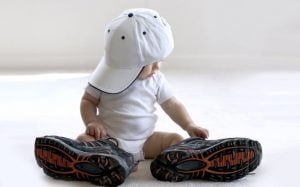
Whether it’s your toddler’s first pair of shoes or a new pair of trainers for your child, finding the right shoe size is important.
As well as causing discomfort or pain now, wearing incorrect shoe sizes can also cause issues further down the line as an adult, like hip and back problems.
Your children’s feet are like their pension – look after their feet now, and they’ll look after them in later life.
Ill-fitting shoes can rub and cause blisters, and shoes that are too big can cause what we in the industry call claw foot. Kids will be curling up their toes to keep their shoes on, which can become a habit and then cause issues.
Buying the right shoe size for now, not a size bigger for them to grow into, is therefore key.
And that also means getting your child’s first pair of shoes at the right time, too.
I always recommend waiting until your child is fully mobile – walking confidently and independently – before you come and get them fitted for their first walking shoes. Prior to that, we recommend bare feet at home.
You don’t want restrictive footwear on kid’s feet. Feet need freedom to grow, move and stretch to strengthen their bones.
Once your child is “cruising” the furniture, and beginning to want to spend more time on their feet outside (albeit still requiring to hold onto hands for support), then pre-walkers are recommended. Pre-walkers offer warmth and protect feet without restricting natural movement. From this, kids will then graduate to first walkers which should still have a flexible sole unit, but offer more support than a pre-walker.
Regardless of what stage of footwear your child is at, at the moment (when you can’t just pop to the shops to have their feet measured), getting the right shoe size likely feels a bit tricky.
Here are some tips for measuring your child’s feet.
- Many shoes have removable insoles. Children’s feet sweat a lot so they leave an imprint on the sole. A quick and easy way to check if your child requires the next size up is to simply remove the insoles in BOTHshoes (as one foot may be larger than the other), and check where the largest toe imprint is (remembering that not every child’s big toe is their longest toe). If the imprint is near or at the top of the insole then it’s time to size up.
- If the shoes do nothave removable insoles, then you can check the fit by pressing the top of the shoe to feel where the toes are. Ask your child to wiggle their toes so you can feel accurately where their toes are. Some shoes have very strong toe bumpers which makes feeling where their toes are difficult. In this case, open up the shoe and look for the imprint on the insole or put your hand in the shoe and you should be able to feel the imprint on the insole.
- Check your child’s feet regularly for any red marks on the top of the foot or on the small toe. If there are red marks, this means that the shoes are too small.
- Not all shoes grow out length ways, especially if your child has a broader foot. If you can’t fasten the Velcro straps completely or the shoe feels tight to get the foot in, then it’s time for the next size up.
- If you do require new shoes for your child, then PLEASEremember that all brands and styles fit differently. Therefore to save any mis-fitting or having to return shoes that don’t fit, it would be beneficial to purchase the next size up in the SAME brand and style. If you are looking to change the style, especially as we are now coming into the colder months, I highly recommend that you seek advice from your local children’s shoe shop, who will be glad to offer remote sizing advice. All independent children shoe retailers are passionate about children’s foot health, and will help in any way they can to ensure your child has well fitted shoes.
To find out more, book an appointment with your Resonance Podiatrist today.
0800 473 776
